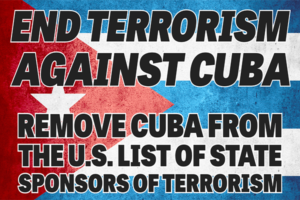| By W. T. Whitney Jr. | September 2, 2013 |
The current agrarian strike in Colombia follows an earlier one in Catatumbo department where small farmers mobilized for land and sustainable lives. Now protesters reject free trade agreements Colombian signed with the United States, Canada, and the European Union. The uprisings are reminders that Colombian struggle over land predisposes to violent conflict. Thats the history behind talks in Cuba now between the Colombian government and FARC insurgents.
Rural Colombians are suffering: 80 percent of them are poor, 25 percent of them extremely so; eight million Colombians are hungry, and 17,559 small farmers suffered human rights abuses over 25 years, with murder the most common form of violence.
On August 8 outside the Ministry of Agriculture in Bogota, leaders of the Table of Agrarian Discussion (MIA) issued demands and announced a strike. Death threats from paramilitaries showed up in their emails afterwards. MIA includes Patriotic March, a two-year old amalgam of 1500 social and political groups that organized 60 percent of the protest actions that would follow.
Since August 19, 200,000 farmers, farm workers, truckers, and small miners have demonstrated and blocked highways in most Colombian departments. Urban protesters joined in after August 25. State repression at the hands of ESMAD riot police and soldiers intensified the face off. By September 1, nine protesters were dead, two hundred wounded, and hundreds detained.
The national strike as such does not exist, said President Santos on August 25. Five days later – one day after large demonstrations in Bogota, Tolima, and elsewhere he gave up the presidential residence for police headquarters. Santos put Bogota under military rule and deployed 50,000 troops to help keep highways open. His government offered to pay for information leading to the arrests of protest leaders.
On August 29 tear gas, clubs, helicopters, and armored vehicles blanketed Bogota. In Boyacá, police invaded homes and stole money and food. Torture and sexual abuse emerged, along with indiscriminant use of gas, explosives, and firearms. Video depictions circulated showing the police urinating on demonstrators food, breaking windows, destroying homes, hitting and humiliating people in their own houses, wounding children, women, and old people, and infiltrating marches. A video titled Collection of videos: abuse by Colombian authorities is so graphic that Spanish language abilities are unnecessary.
Officials identified protests groups as vandals. President Santos accused Patriotic March of spurning government agreements with regional farmers. Patriotic March leader Andrés Gil charged that government negotiations with farmers in Boyacá, Nariño, and Cundinamarca were aimed at dividing the protest movement, especially with those negotiations being cast as covering all mobilizations. Elsewhere, peasant organizations are asking for land and peasant reserve zones, indigenous peoples want reservations, and Afro-Colombians and [other] popular sectors want rights. Small farmers in those departments – in Catatumbo, for example – occupy land coveted for natural resources extraction, ranching, and industrial agriculture.
The government uses the lack of centralization of the movement which is its great weakness to mount sectional and regional negotiations. Farmers on fertile land in Boyacá and the two other departments sell vegetables, grains, meat, and dairy products on the domestic market. Free trade agreements have hurt them and they are discussing subsidies, tariff adjustments, and lowered fertilizer and herbicide prices with the government.
One year after the Colombian U.S. free trade agreement went into effect, Colombian food imports from the United States were up 81 percent with rice registering a 2000 percent increase; vegetable oils, 200 percent; frozen potatoes 200 percent; pork 95 percent; and dairy products, 90 percent. The Tunja archbishop Luis Augusto Castro condemned the agreements as treason to the country.
The agrarian strike expanded after August 25, with students, unionists, and human rights activists filling city streets. A University of Tolima student told a reporter: We are not inclined to hand over our country and do away with Colombian agriculture. She added: no more privatized universities, no more universities increasing their entry fees. The Broadened National Student Federation (MANE) launched demonstrations in several cities.
The University Professors Union issued a statement demanding immediate denunciation of the free trade agreements, since these are treason to the country. And, We call for sincere dialogue in Havana … and a national constituent assembly.
Labor unions are involved, notably the Workers Labor Union (USO) and the Fensuagro agricultural workers union. Fensuagro Vice President Huber Ballesteros, an officer of the CUT labor federation and a MIA spokesperson, has been in prison since August 25. Jailed on charges of rebellion and terrorism frequently used to link opposition leaders to the FARC, Ballesteros is a magnet now for international solidarity.
Demonstrations continue despite repression. The government is stymied, a commentator says, because the oligarchy, committed to neo-liberalism, cannot solve agrarian conflict touching upon all society without resort to violence. Thus with giant steps they are getting close to a revolutionary type crisis. And a social leadership of a new type is coming to the fore. It understands the problem is structural.
The Tolima hospital workers union president Nelsy Gómez Oliveros testified to a new phase of struggle. President Santos … We are here in the streets for health care, education, the environment, jobs, and dignity as Colombian people. No more attacks! No more violence! No more war! [T]oday we the Colombian people are showing we have blood in our veins and that we are inclined toward struggle, even to sacrifice.
_____
Photo: CNEP, Revista Semana
____________________




